The Intel SSD 600p (512GB) Review
by Billy Tallis on November 22, 2016 10:30 AM ESTMixed Random Read/Write Performance
The mixed random I/O benchmark starts with a pure read test and gradually increases the proportion of writes, finishing with pure writes. The queue depth is 3 for the entire test and each subtest lasts for 3 minutes, for a total test duration of 18 minutes. As with the pure random write test, this test is restricted to a 16GB span of the drive, which is empty save for the 16GB test file.
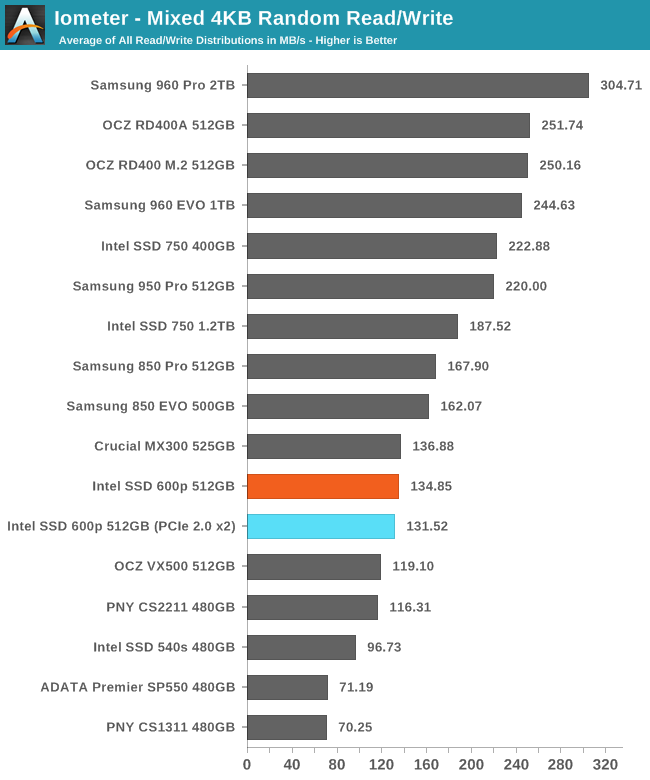
The 600p was slower than the Crucial MX300 on random writes but faster at random reads. On the mixed random I/O test, they average out to a tie.
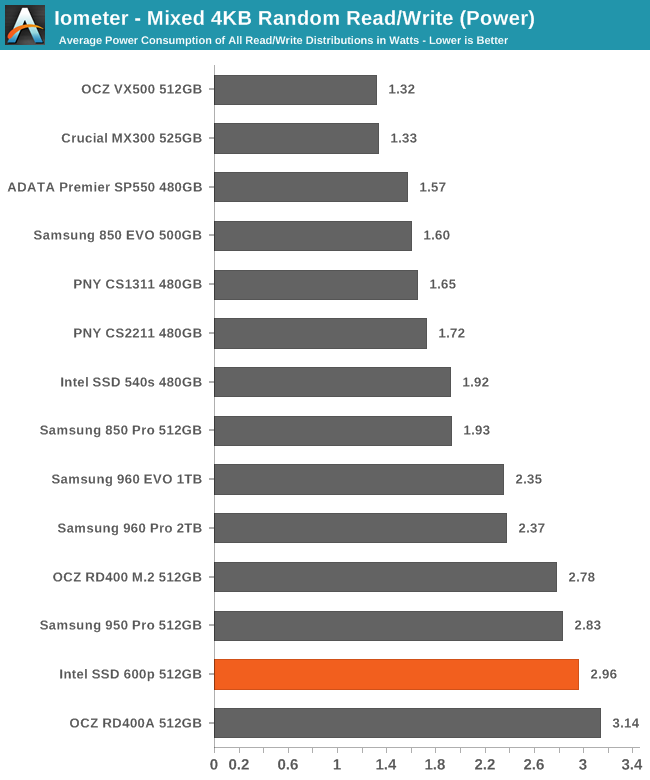
Despite performing the same overall, the 600p used more than twice the power of the MX300. The SM2260 controller simply imposes far too much power overhead than is appropriate when paired with slow TLC NAND.
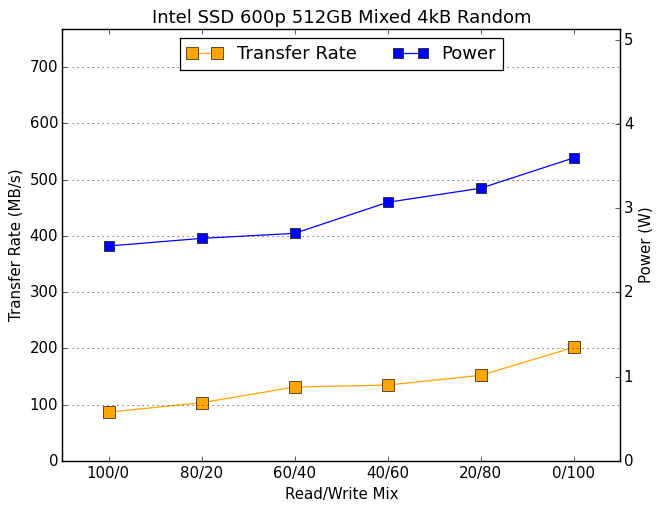 |
|||||||||
The 600p performs better as more writes are added in to the mix, but it doesn't spike in performance for the final all-writes phase of the test. This means its performance is much more balanced than many other drives that simply run up the score at the end.
Mixed Sequential Read/Write Performance
The mixed sequential access test covers the entire span of the drive and uses a queue depth of one. It starts with a pure read test and gradually increases the proportion of writes, finishing with pure writes. Each subtest lasts for 3 minutes, for a total test duration of 18 minutes. The drive is filled before the test starts.

The faster-than-SATA read speeds of the 600p aren't enough to compensate for the poor write speeds, so it ends up scoring only slightly ahead of the budget SATA SSDs.
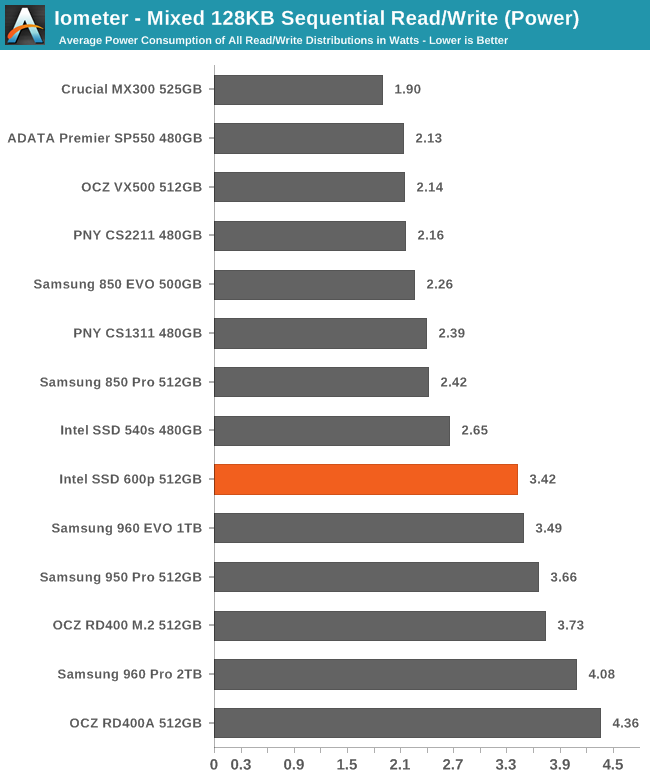
There is a clear separation in power consumption between the SATA and PCIe SSDs. For once, the 600p is the lowest power PCIe SSD, but it is still the least efficient due to its low performance.
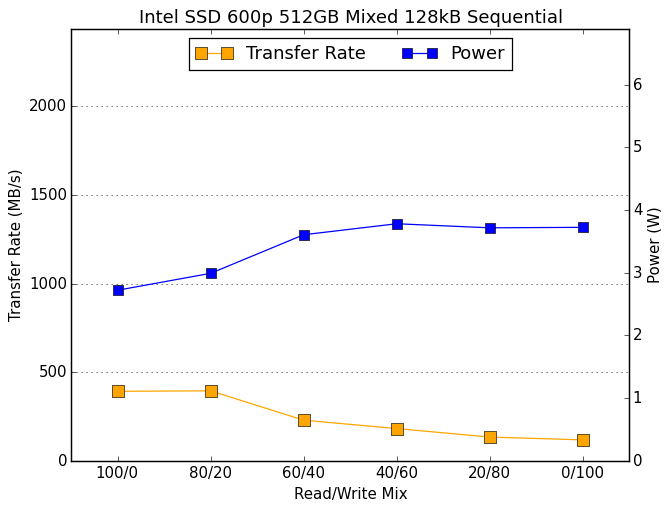 |
|||||||||
As expected, adding writes to the mix drags down performance, though there aren't enough writes in the 80/20 phase to have much of an impact yet. It is a hallmark of low-end SSDs to see performance stay low through the end of the test, while high-performance SSDs typically have a U-shaped performance curve here.










63 Comments
View All Comments
Billy Tallis - Tuesday, November 22, 2016 - link
The old firmware. The testbed has been too busy with PCIe SSDs lately for me to have a chance to put the November MX300 update through its paces.seanmac2 - Wednesday, November 23, 2016 - link
I would never intentionally buy this product but it bothers me anyway because laptops advertise things like "512 GB PCIe SSD" and I'm left wondering if I'll get this or something sweet like a Samsung 950/951/960.ddriver - Wednesday, November 23, 2016 - link
You get what you pay for. The 600p will likely go into budget products, which won't be CPU powerhouses which may be limited by the sdd performance. Most applications, even prosumer grade software, shows like 1-2$ improvement from going sata to nvme, and this particular product, although technically nvme is more in the sata ballpark.Flying Aardvark - Friday, November 25, 2016 - link
That's why Intel products cost more than others. You do get what you pay for. Intel SSDs have the industry's best reliability, which matters most when your drive fails prematurely. Unlikely if using M.2 you'll see any real world difference between the 600P and anything else.The true step up is the heavy duty Intel 750 stuff with heatsink and zero throttling concerns under heavy, sustained load.
Meteor2 - Wednesday, November 23, 2016 - link
A suggestion: you could link to the previous reviews of devices the first time you mention them, e.g. the 850 Evo. Would save hunting around for them/encourage more page views a people read those reviews before coming back.Meteor2 - Wednesday, November 23, 2016 - link
So where's this drive falling down compared to the other NVMe drives? Is it the TLC NAND, the construction of the dies, the controller, or something else?DominionSeraph - Wednesday, November 23, 2016 - link
"1750MB/s sequential read", and not a single test showing if it could actually reach 1750MB/s sequential read in any real life tasks.Great job there.
beginner99 - Wednesday, November 23, 2016 - link
WTF is this? It's another useless TLC crap drive. Intel, your ruining your reputation and brand with crap like this. I don't see why I should buy this over a MX300 or similar crappy TLC entry level ssd that is even cheaper.Flying Aardvark - Friday, November 25, 2016 - link
Everything is going to be 3D TLC soon except the truly next-level stuff like the Intel 750. 3D TLC is not planar TLC.creed3020 - Wednesday, November 23, 2016 - link
Billy, when are these results going to be included in Bench? I was hoping to compare to my Crucial MX100 but cannot find these Intel drives under SSD2015.